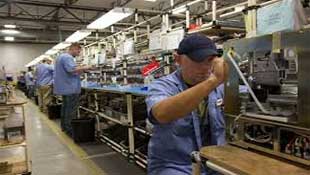| |
|
| |
|
 |
Supply
Chain by the Numbers |
| |
|
| |
- May 20, 2021
|
| |
|
| |
|
| |
|
| |
Q1 Industrial Robot Growth is Strong in Q1; Breakthrough Low Cost RFID Tag? US Manufacturing Output Inches Up in April; Global Chip Shortage Getting Worse |
| |
|
| |
| |
| |
| |
9098 |
|
That was how many industrial robots of all sorts were ordered in Q1 in North America, worth a total value of $466 million. The number of robots ordered was up 20% versus Q1 2020, and it seems likely that 2020 number was not really impacted by the start of the pandemic in March of that year. All that according to recently published data from industry group Association for Advancing Automation (A3). Q1 also saw substantial increases in purchases coming from companies in the metals sector (up 86%), life sciences/pharmaceutical/biomed (up 72%), and food & consumer goods (up 32%). In 2020 overall, for the first time, orders of robots from non-automotive sectors surpassed automotive robot orders. However, sales of robotic units in North America increased just 4% in 2020 from 2019, in a number that likely was much lower than would have been the case without the impact of COVI-19. |
|
|
| |
| |
|
|
 |
| That was the reading for the US manufacturing output index for April, as reported last Friday by the Federal Reserve Bank. That was up a bit from an upwardly revised score of 102.8 in March. The index is ever so slowly inching towards the level of about 105 seen in February 2020 before the pandemic hit in the US in March. However, the score is still well below the record level of about 110 reached in 2007. It also means that at 103.2, the index was just 3.2% higher than the baseline year of 2012 (index = 100) now nine years later, meaning an annual growth rate of well less the half a percentage point. Factory capacity utilization in April was 74.1%, versus the average from 1972-2020 of 78.1%. |
| |
| |
|
|
| |
| |
17 |
 |
That was the average lead time in weeks during April for semiconductor deliveries. That according to analysis released this week by Susquehanna Financial Group. That is the longest wait since the firm began tracking the data in 2017, and puts the chip market what it describes as the “danger zone.” Chip shortages are impacting industry after industry, disrupting manufacturing of products from cars to game consoles to refrigerators to semi-trucks. That’s undercutting US and global economic growth and employment, and leading to concern of panic ordering that will exacerbate the situation and lead to market distortions in the future. As an indication of how bad the situation is, NXP Semiconductors NV, a major auto chip supplier, has lead times of more than 22 weeks now, up from around 12 weeks late last year. STMicroelectronics NV, another key auto chip supplier, saw lead times rise by four weeks in April to more than 28 weeks. Incredible. On Wednesday, Ford announced plans to halt production of popular F-150 truck, Bronco Sport and other vehicles due to the chip shortage. |
| |
| |
| |
| |
| |
|
|
|
| |
 |
 |
| |
 |
![]() |
 |
|
| |
 |
Feedback |
|
|
|
![]()
|
No Feedback on this article yet.
|
|
![]() |
|
|
|
![]() |
 |
![]() |
 |
|
| |